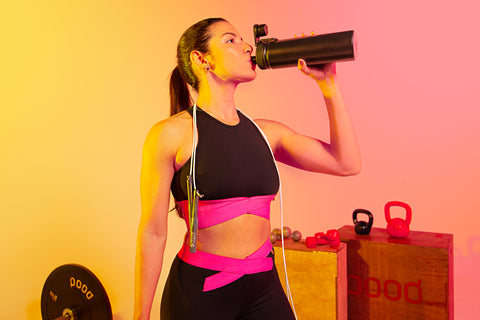5 Strategies to Prevent Peeing While Jumping Rope
May 17, 2024Devin Meek

Has this ever happened to you? You “pee a little” when you jump rope or do double unders? What’s up with that? And how do you get it to stop? Here we’ll tackle the subject of peeing when you jump rope, and suggest five strategies to help you stay dry and confident during your workouts.
Before we talk solutions, let's recap why jumping rope sometimes leads to bladder leakage in women. The act of jumping puts pressure on your pelvic floor muscles, which can weaken over time due to various factors like childbirth, age, or high-impact exercises. These are the muscles you use to “hold it in” either stopping the flow of urine midstream or preventing you from passing gas. So if your pelvic floor muscles are weak or weakened, you're vulnerable to leaks with increased pressure.

The biggest thing you can do is work on strengthening your pelvic floor muscles. A strong pelvic floor is crucial for bladder control. Incorporate exercises like Kegels into your routine to strengthen these muscles. A simple exercise is thinking about which muscles you use when you “hold it it,” and contracting these muscles for about 3 seconds, then relax for 3 seconds. Aim for 10-15 repetitions, gradually increasing the duration of each contraction as you become more comfortable. It's important to breathe freely and avoid tensing your abdomen, buttocks, or thighs during the exercises.
Poor jumping posture can make bladder leakage worse. Keep your spine straight, shoulders back, and core engaged while jumping. This posture distributes pressure more evenly throughout your body, reducing strain on your pelvic floor. Check out our guide on how to get better at jumping rope.
It may seem counterintuitive, but staying hydrated actually helps prevent bladder leakage. Dehydration can irritate the bladder and exacerbate incontinence. Aim to drink plenty of water throughout the day to keep your bladder happy and healthy.
Then, right before starting your jump rope session, make sure your bladder is empty. An active bladders is good, but a full bladder will put extra pressure on your pelvic floor, increasing the likelihood of leakage. Take a quick bathroom break before you start jumping!
If you're experiencing frequent bladder leakage, consider wearing protective gear like absorbent pads or specialized underwear designed for incontinence. This extra layer of protection can give you peace of mind during your workouts.
Again jumping rope isn’t the cause of urinary incontinence. Peeing while jumping is just a symptom of a weak pelvic floor. By implementing the strategies mentioned above, you can minimize the risk of incontinence while enjoying the benefits of jumping rope.
Jumping rope can strain the pelvic floor if done improperly or excessively. However, with proper technique, posture, and pelvic floor strengthening exercises, jumping rope can be a safe and effective workout for most individuals.
Don't let bladder leakage hold you back from enjoying the countless benefits of jumping rope. By following these five strategies, you can jump with confidence and comfort. Remember, consistency is key. Stay committed to strengthening your pelvic floor and maintaining good posture, and soon you'll be leaping over obstacles without a second thought.
Ready to upgrade your jump rope game? Shop Elite Jumps' premium collection of jump ropes. Jump to it and reclaim your workout today!
 |
About the AuthorDevin Meek is the Director of Education for Elite Jumps. He's been a jump rope entertainer for over eighteen years and is a three-time world champion competitive jumper. Devin travels the country sharing his passion for the sport, giving jump rope workshops to schools, CrossFit gyms, and corporate wellness programs. |
We're all about equipping and encouraging people to take on big challenges, because we know the process of doing hard things helps us grow in character and capacity.
Frequently bought together
You may also like
0 Comments
There are no comments for this article. Be the first one to leave a message!